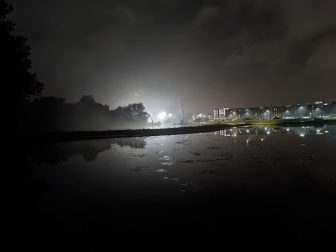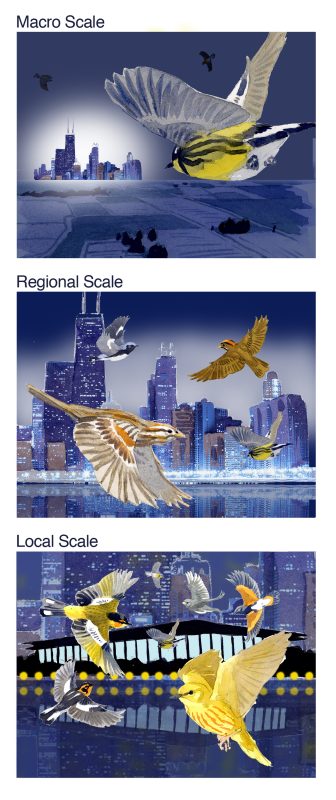
A pond in East Lansing, Michigan, glows from light pollution despite the late hour. Image: Nicoline Bradford
By Nicoline Bradford
When night falls over the Great Lakes the sky still glows from city lights, threatening birds and other migratory species.
As artificial light seeps into and accumulates in the environment, it harms people and wildlife, said Carolyn Burt, a research coordinator at Colorado State University. It affects circadian rhythms, hormone production and behaviors such as foraging and reproduction.
Researchers recently reviewed years of data to better understand how light pollution harms migratory species. The review, published in the scientific journal Trends in Ecology & Evolution, found that the impact occurs at the local, regional and larger scales.
At the macroscale, light pollution draws birds off their migratory routes, according to the paper. Then, at the regional scale, the light disorients them and pulls them further off course. At the local scale, they risk crashing into buildings.
These collisions are frequent. In the United States, around a billion birds crash into windows each year, according to the United States Fish and Wildlife Service. Many die.
While light pollution is a nationwide problem, Chicago offers an excellent case study. The paper highlighted a study done at McCormick Place Convention Center in Chicago, Burt said.
It is hard to collect death rates of birds colliding with buildings, said Kyle Horton, an assistant professor at Colorado State University. The study at McCormick Place is unique for the amount of data collected daily for over 40 years. Also unique is the record kept of when the lights were on or off.
The study could draw a direct correlation between light pollution and bird collisions.
The impact extends beyond birds.
Studies found that light pollution affects the circadian rhythms of monarch butterflies so that they take off at different times, Burt said. This disrupts their migratory patterns even though they migrate during the day.
The monarchs and other diurnal, or daytime, species are just as vulnerable to light pollution as nocturnal species, according to the paper.

Using Chicago as a case study, researchers studied the impact of light pollution on local, regional and larger scales.: Image: Debby Kaspari from The effects of light pollution on migratory animal behavior
Despite the complexity of the issue, there is a relatively simple solution, Burt said. Turn off the lights.
It may not always be practical to eliminate artificial light, but even just shading it or switching to a warmer color can make a huge difference, Burt said.
Turning off lights during migratory seasons is especially effective, Horton said. There are several resources available to help people be more mindful of their light. BirdCast is a tool that predicts bird migration across the nation, said Horton, who works on the BirdCast team. It uses weather radars and migration data to provide real-time information.
“We’re so used to being around artificial light, that I think we forget that it is a pollutant,” Burt said.
Unlike other pollutants, however, it really can be as simple to control as flipping a switch.